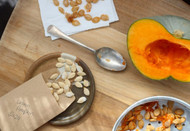Posted by Originally published by Sage Journal as part of the Autumn Gardening Series
13th May 2025
How to harvest & store pumpkins and potatoes
An autumn guide to harvesting, sorting, seed-saving and storing pumpkins and potatoes.
As autumn approaches, gardeners are finally rewarded with the fruits of their labour. Autumn
in the garden means harvest season, with pumpkins and potatoes, for many, being high on the
list. Understanding the right time to pick and how to store these crops can make a big difference
in your winter pantry. Here are some straightforward tips to help you make the most of your precious harvests this
autumn.
Harvesting pumpkins
You’ll know it’s time to harvest pumpkins when they’re at a decent size, and the skin deepens in colour and hardens off. You will notice the vine begin to shrivel and dry too, and the tendrils closest to the pumpkin will die back completely.
At this point it’s ok to cut the pumpkin from the vine, leaving about 10cm of stem which helps the pumpkin to cure and prevent rot. A withered stem also prevents insects from entering and causing damage.
Once inside, don’t store on a cold, concrete floor or similar which can lead to rot. Store on top of cardboard, a piece of wood or even hang up inside a fabric or mesh bag.
Saving pumpkin seeds
When the time comes to use your pumpkin, select the best-looking ones to save seeds from. You can simply scoop the seeds out and wash in a colander before leaving out on a paper towel to dry off. Once dried completely, you can store in a paper envelope to sow the following year. Pumpkin seeds can last for up to six years if stored correctly – in a cool, dry place away from
direct sunlight.
Harvesting potatoes
You can eat potatoes straight out of the ground after they’ve flowered, but if your intention is to store them over the winter, you need to wait until the potato plant yellows and dies back. Waiting 2-3 weeks after foliage die-back for the skins to harden can increase their storage ability. Waiting for a period of dry weather, if possible, will make the process easier. And leaving the soil on the potato to dry off before storing is best to avoid rot.
Sorting & saving seed potatoes
Once harvested, you can sort the potatoes out into piles – for storage, to be eaten straight away or thrown away.
- Any potatoes that have gone green or are rotting will have to be discarded.
- There will be potatoes that should be put into an ‘eat now’ pile. This may
include potatoes that have minor skin damage or feel a bit soft. - Potatoes for storing will feel firm, with no wounds.
Harvest stage is a good time to save your seed potatoes for spring. To do this, pile each crop
(all potatoes per plant) and select the healthiest looking potatoes from each pile. Store in a
sack in a cool, dark place to stop them from sprouting until next planting season.
Winter storage
Pumpkins usually last three months in a cool, dry place but can store up to six months if you are lucky. Pumpkins continue to ripen after they are picked so storing upside down can aid in this process, and is said to make the pumpkin taste even sweeter. (Be careful not to damage the stalk if you choose to do this.)
Potatoes prefer cool, slightly humid conditions, stored in the dark to prevent sprouting. A cardboard box with newspaper at the bottom or a sack below the pantry should be sufficient for most gardeners. The main thing to remember is that warmth and light will trigger sprouting in potatoes, so keeping them cool and dark is the main thing.
________________________________________________
The Sage Journal Autumn Gardening Series is supported by Gubba Garden Store.


























